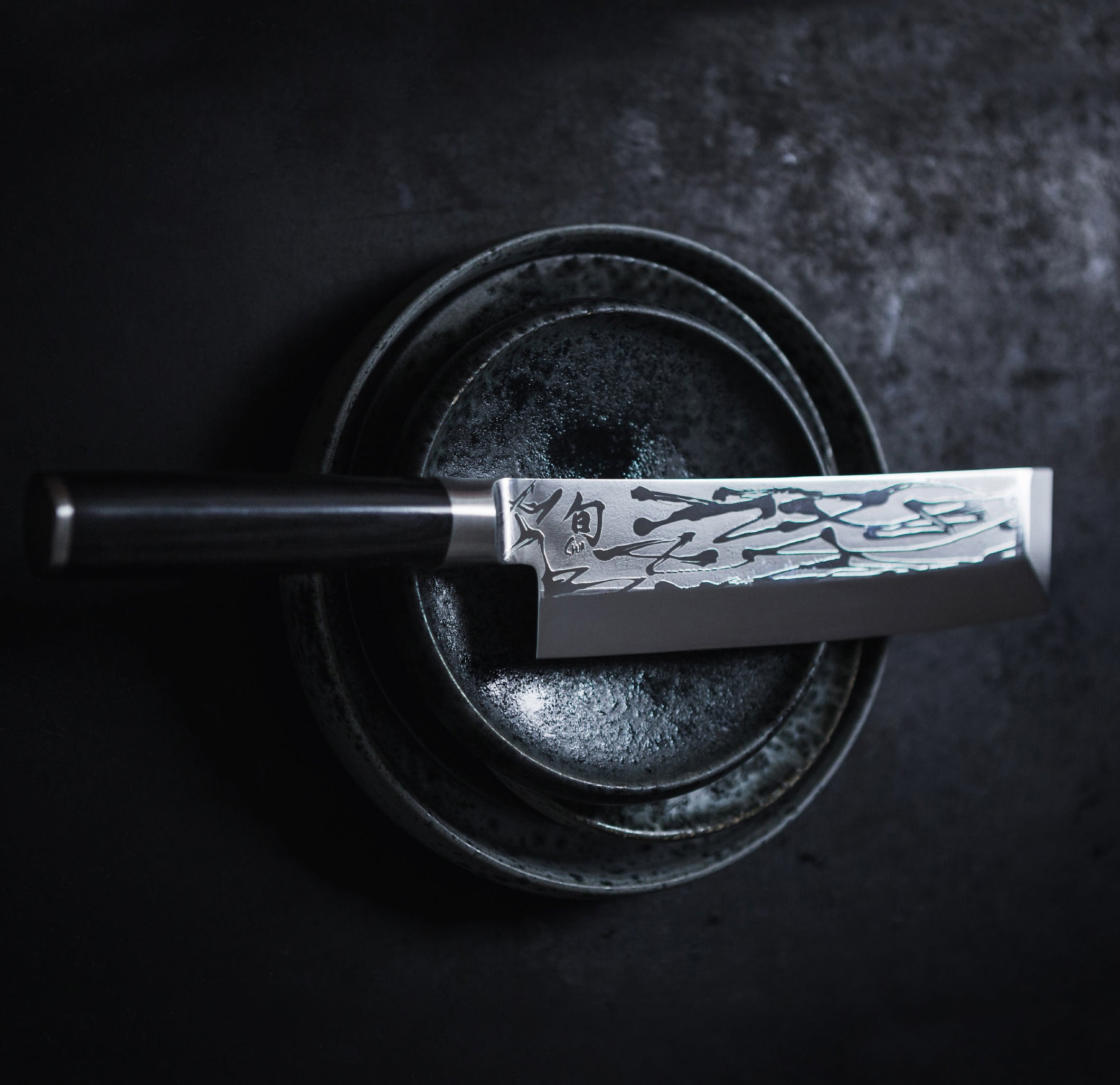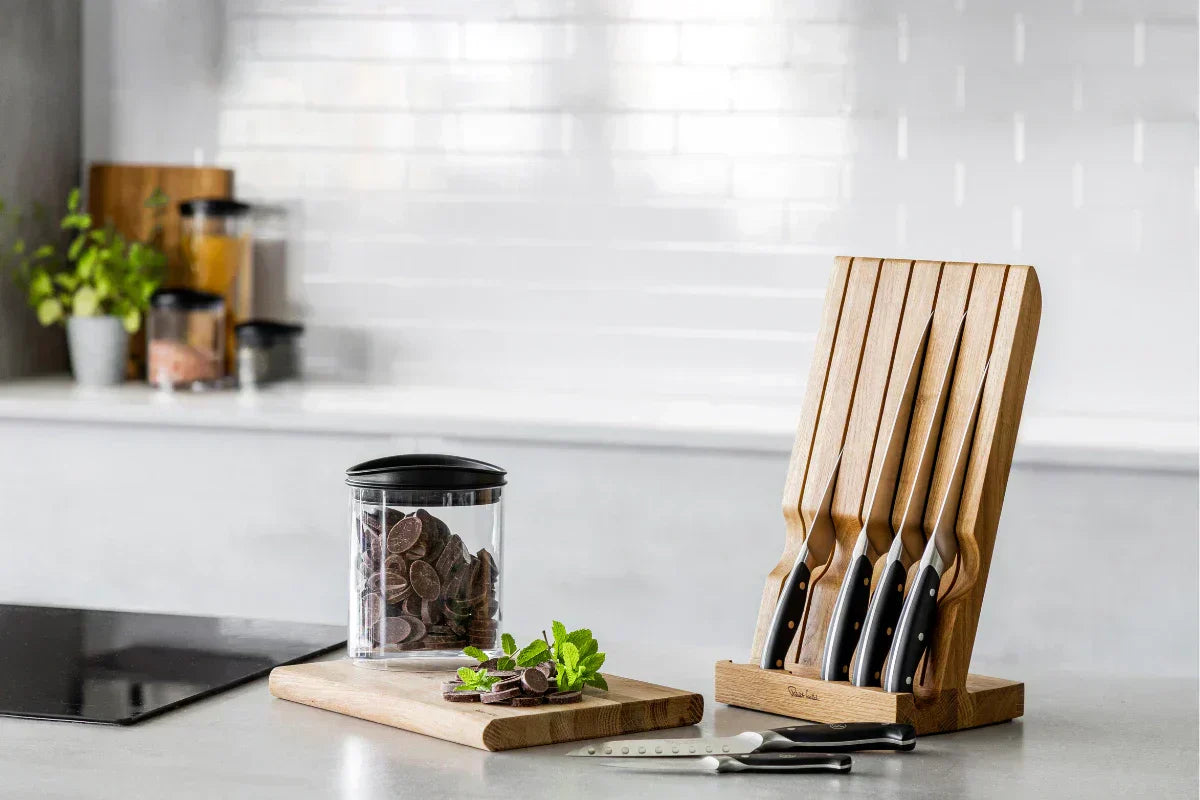When & How To Use The Nakiri Knife

In this post, we'll be delving into the world of nakiri knives and exploring their various uses and benefits in the kitchen. Whether you're a passionate home cook or a professional chef, a nakiri knife can be an indispensable tool that enhances your culinary experience. We'll take a closer look at the anatomy of a nakiri knife, its distinctive characteristics that set it apart from other knives, and the specific cutting techniques and tasks that the nakiri knife excels at.

What Is a Nakiri Knife?
A nakiri knife is a versatile Japanese blade that distinguishes itself with a unique design. It features a shorter, wider blade compared to a traditional chef's knife, typically ranging from five to seven inches in length. The blade of a nakiri knife is characterized by a straight edge, free from any curve or belly. This straight edge allows for precise and efficient chopping, slicing, and dicing of a wide variety of ingredients, including fruits, vegetables, and even boneless meats.
The nakiri knife's design focuses on its exceptional suitability for vegetable preparation. It boasts a flat profile and a squared-off tip, enabling it to excel in tasks that involve precise, downward cutting motions. The straight edge facilitates clean and uniform cuts, making it a preferred choice for creating beautiful, presentation-worthy vegetable dishes.
With its emphasis on precision and ease of use, the nakiri knife has gained popularity among chefs and home cooks alike. Its shorter length and wider blade provide ample knuckle clearance, reducing strain on your hand and wrist during extended cutting sessions. If you're seeking a dedicated vegetable knife that combines functionality and elegance, the nakiri knife is a remarkable choice.
History & Origins Of the Nakiri Knife
The nakiri knife, like many traditional Japanese blades, has a rich history rooted in the culinary traditions of Japan. Its origins can be traced back to centuries ago, originating from the Edo period in Japan. During this time, the nakiri knife was primarily used by skilled chefs and cooks in Japanese households, who valued its exceptional cutting performance and precision.
The term "nakiri" itself translates to "vegetable cutter" or "leaf cutter," highlighting the knife's purpose and specialization in vegetable preparation. The nakiri knife was specifically designed to meet the demanding needs of Japanese cuisine, where precise and uniform cuts of vegetables are highly valued.
Over time, the nakiri knife has gained recognition beyond Japan's borders. With the growing popularity of Japanese cuisine worldwide, more and more chefs and home cooks have come to appreciate the nakiri knife's unique qualities. Its flat and rectangular blade, combined with a straight edge, allows for efficient chopping, slicing, and dicing of a wide variety of vegetables.
Today, the nakiri knife continues to evolve and adapt to meet the needs of modern kitchens. Different manufacturers offer their own interpretations of the classic nakiri knife, incorporating variations in blade length, handle materials, and design aesthetics. However, the fundamental purpose and essence of the nakiri knife remain true—a tool crafted to excel in vegetable preparation and to elevate the art of Japanese culinary traditions.
Nakiri Knife Techniques
The nakiri knife's flat blade and straight edge make it well-suited for precise vegetable slicing. Place the ingredient on the cutting board and use a smooth, downward motion to slice through it. This technique ensures clean, uniform cuts, allowing you to showcase the beauty and presentation of your vegetable dishes.
For ingredients that require chunkier cuts, the nakiri knife can excel in vertical chopping. Position the blade vertically on the cutting board and use a controlled, downward motion to chop through the ingredient. This technique works particularly well for root vegetables or denser produce, providing consistent results.
The nakiri knife's straight edge enables you to achieve fine, uniform cuts like julienne and brunoise. Start by slicing the ingredient into thin planks, then stack the planks and make parallel cuts to create thin strips or finely diced pieces. This technique ensures precision and consistency in your knife work.
Like the santoku knife, the flat surface of the nakiri knife can be advantageous for cutting flat or thin ingredients. Use a back-and-forth slicing motion with the flat edge of the blade to make thin, even cuts. This technique works well for ingredients like garlic, ginger, or shallots.
While the nakiri knife provides knuckle clearance, it's still important to use a finger guard to protect your fingers during chopping and slicing. Curl your fingertips inward and use your knuckles as a guide for the blade, ensuring safe and controlled movements.
The nakiri knife can be employed for a unique horizontal herb chopping technique. Gather a small bunch of herbs such as basil or cilantro and hold it firmly with one hand. With the nakiri knife, position the blade horizontally against the herbs, making sure the cutting edge is parallel to the stems. Employ a swift and gentle rocking motion, moving the knife back and forth across the herbs. This technique allows for precise and efficient chopping, resulting in finely minced herbs ready to enhance the flavours of your dishes.

Choosing The Right Nakiri Knife
Blade Material: The choice of blade material is crucial as it determines the knife's performance, durability, and maintenance needs. Opt for a nakiri knife crafted from high-carbon stainless steel, which strikes a balance between sharpness, stain resistance, and ease of maintenance. Select a blade material that suits your cooking style and preferences.
Blade Construction: Evaluate the blade construction of the nakiri knife. Look for options with a full-tang construction, where the blade extends into the handle, providing enhanced stability and strength. Alternatively, explore knives with unique constructions like layered steel or Damascus for a blend of aesthetics and performance.
Blade Length: Consider the blade length that aligns with your cutting requirements and comfort. Longer blades offer more surface area for handling larger ingredients, while shorter blades provide increased maneuverability and precision for intricate cuts.
Blade Edge: Nakiri knives typically feature a double-beveled edge, suitable for both right-handed and left-handed users. However, there are also single-beveled options available, specifically designed for traditional Japanese cutting techniques. Choose the blade edge that aligns with your preferred cutting style.
Handle Design: Evaluate the handle design for a comfortable grip, control, and overall user experience. Look for an ergonomic handle that feels secure and well-balanced in your hand. Common handle materials include wood, synthetic materials, and composites. Choose a handle material that offers a comfortable grip and matches your aesthetic preferences.
Brand and Reputation: Research reputable brands known for manufacturing high-quality nakiri knives. Take into account customer reviews and recommendations to ensure you select a knife from a trusted and respected manufacturer.NTop of Form
Nakiri Knife vs The Chefs Knife
While a chef's knife is versatile and can handle various tasks, it may not provide the same level of efficiency and precision when it comes to vegetable preparation. The nakiri knife's flat blade and straight edge excel at slicing, chopping, and dicing vegetables, allowing for more controlled and consistent cuts. If you frequently work with vegetables and desire a specialized tool for efficient vegetable preparation, the nakiri knife is a better choice.
Chef's knives, with their curved blades, may be more prone to food sticking to the sides during cutting, especially with moist or sticky ingredients. In contrast, the nakiri knife's flat blade and straight edge minimize food adhesion, allowing for smoother and more effortless cutting. This feature is particularly beneficial when working with ingredients like potatoes, squash, or sticky fruits.
The chef's knife's curved blade is excellent for rocking motions and general-purpose cutting but may not provide the same level of precision when it comes to creating uniform and visually appealing vegetable slices. The nakiri knife's straight edge enables clean, straight cuts, making it ideal for achieving consistent thickness and elegant presentations. If you prioritize aesthetic presentation in your culinary creations, the nakiri knife can help you achieve desired results.
The chef's knife is a versatile workhorse, but its design may not prioritize the same level of comfort and fatigue reduction when extensively used for vegetable preparation. The nakiri knife's wide blade and knuckle clearance contribute to reduced strain on your hand and wrist during prolonged cutting sessions. If you engage in extensive vegetable prepping, the nakiri knife's ergonomic design can offer more comfort and reduce fatigue.
Owning a nakiri knife alongside a chef's knife allows you to have specialized tools for specific tasks. By dedicating the nakiri knife to vegetable preparation, you can maintain its sharpness and avoid cross-contamination between ingredients. This separation of tasks ensures that each knife remains in optimal condition and prolongs their lifespan.
Nakiri Knife Maintenance
Avoid using a dishwasher for cleaning your nakiri knife, as the high temperatures and harsh detergents can damage the blade and handle. Instead, hand wash it with warm, soapy water after each use. Thoroughly dry the knife with a clean towel to prevent water spots and rust formation on the blade.
A sharp nakiri knife is essential for safe and efficient cutting. Regularly use a sharpening stone or honing steel to maintain its sharp edge. A honing steel is recommended for regular maintenance, while a sharpening stone is useful for more extensive repairs.
Store your nakiri knife correctly to prevent damage and ensure safety. Avoid storing it in a drawer with other utensils, as they can scratch the blade. Instead, use a knife block or magnetic strip to securely hold the knife in place and protect the blade.
Handle your nakiri knife with caution to prevent damage to the blade and handle. Avoid using it to cut through hard or frozen foods, as this can result in blade damage. Additionally, refrain from twisting the blade while cutting, as this can lead to chipping or breakage.




